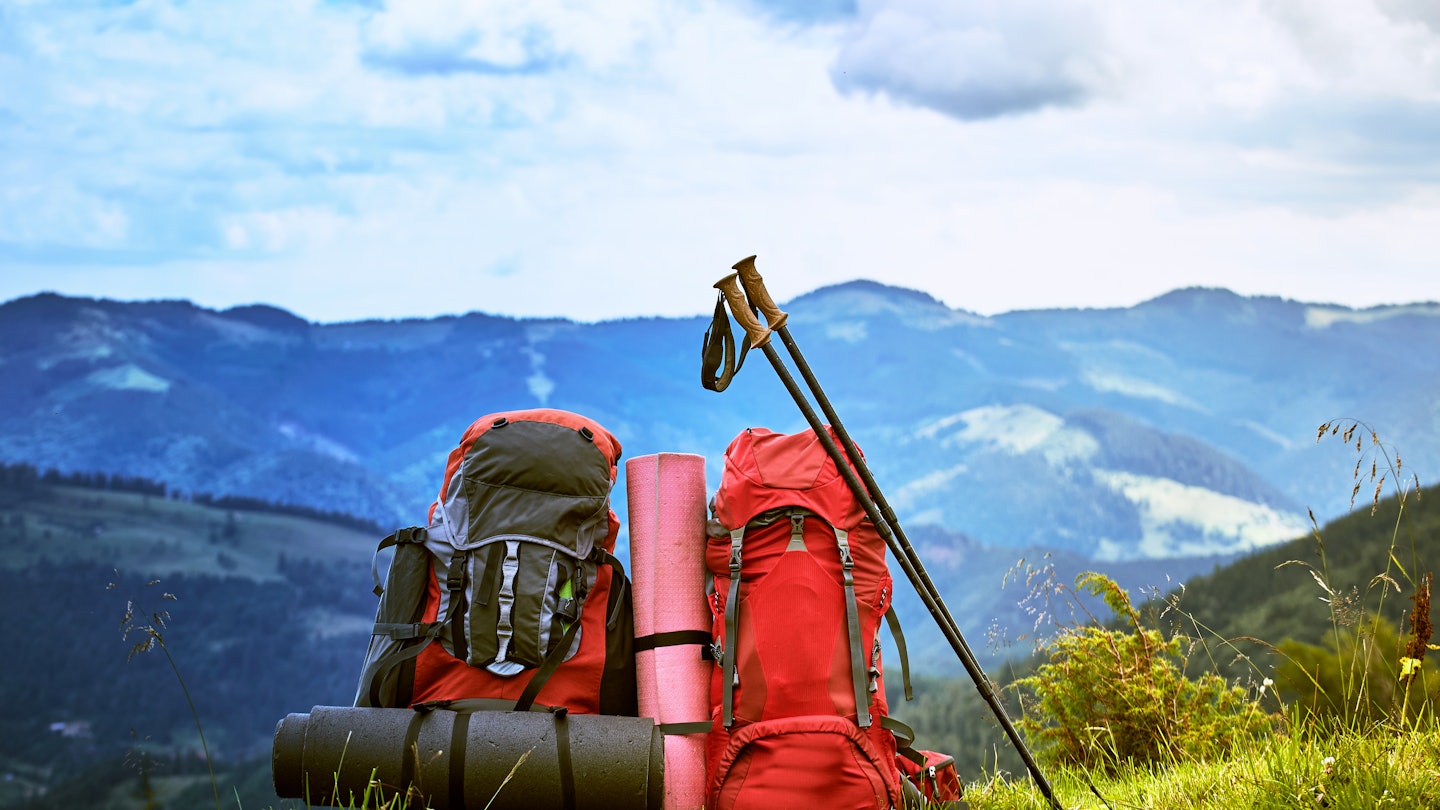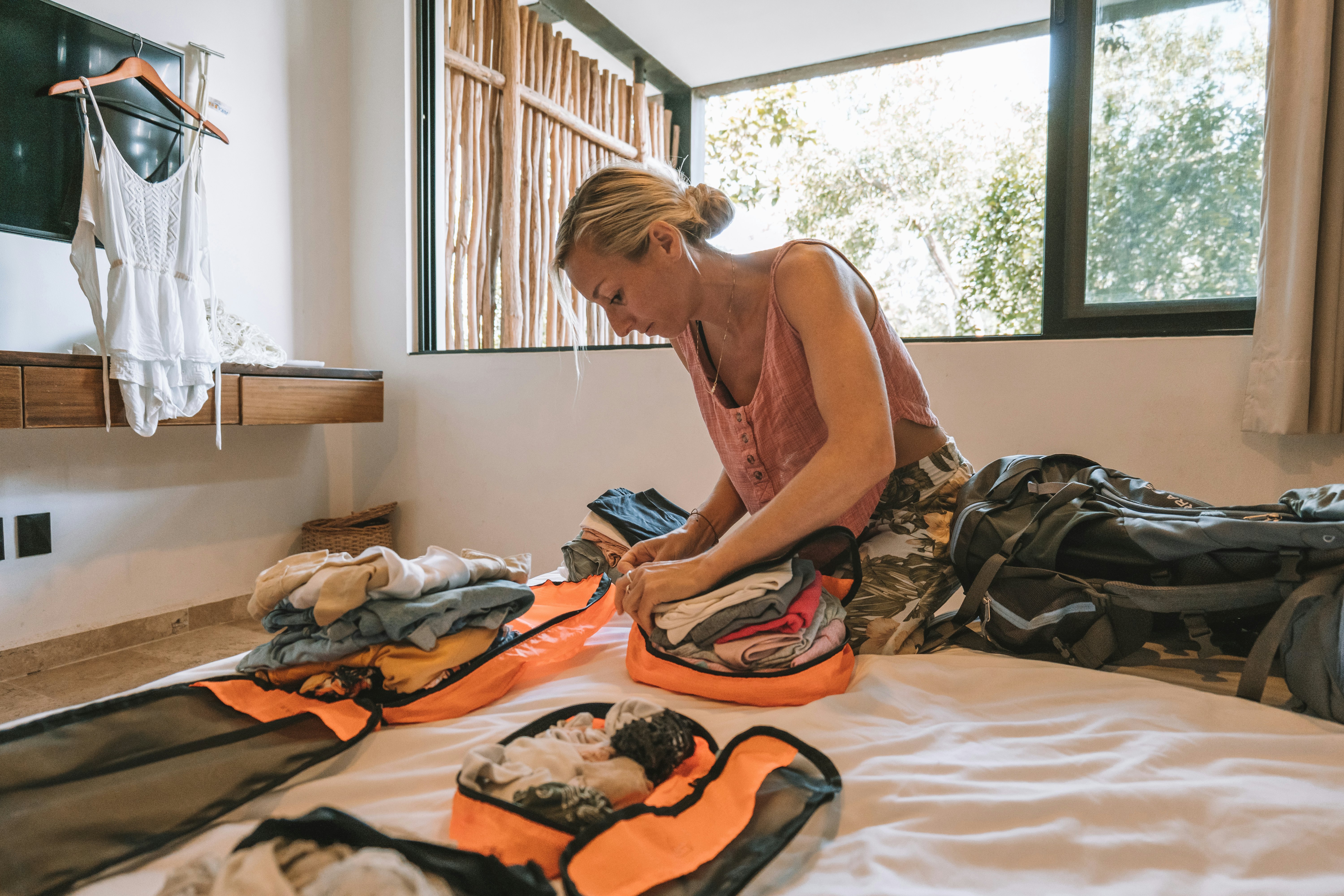

Backpacks on a hillside. trek6500/Shutterstock
You've planned your flights and booked your dream backpacking trip. Now there’s nothing standing between you and the unforgettable adventure that’s about to unfold. All you have to do is figure out what to bring and how to pack.
Whether you're traveling around one country or 10, you can create the perfect travel packing list with this essential guide.
Here's how to choose the right backpack, maximize space and pack versatile clothing for any trip.

Choose the right backpack
Before you decide what you're taking, you need to determine what to take it in. With so many brands and models to choose from, finding the right backpack for you can seem like an overwhelming task. The web is rife with advice from people who insist you can travel for six months with nothing but a small carry-on, while others woefully recall their experience of lugging a fully loaded 90L pack around the world.
The sweet spot lies somewhere in the middle: a 40–70L backpack is fine for a long-term trip. The trick is to avoid stuffing it too full. First-time travelers are often tempted to take everything but the kitchen sink (just in case!), but limiting your backpack space is the best way to avoid this common pitfall.
Something like the Kelty Redwing 50 for men or women is a great option. The durable 50L pack has an internal frame and performs well whether you're out on the trails or jumping from hostel to hostel.
If you can, go into an outdoors store to try on a range of backpacks for size and fit. A backpack that fits your 6ft-tall, broad-shouldered travel companion might not be right for you if you have a much smaller frame. Make sure you spend time adjusting the shoulder straps, back length and hip straps to check that it fits your own body well.
Remember to take a good-quality day pack, too, which you can store inside your backpack or use as hand luggage. Consider the Osprey Ultralight Stuff Pack. At just over 5oz (around 150g), it's won't weigh you down when you're not using it.

Maximize space with packing cubes and compression sacks
When it comes to maximizing space in your backpack, stuffing socks inside shoes will only get you so far. Believe me – compression sacks are your new best friends. Besides saving considerable space, they can protect clothing from grime and spillages and let you separate dirty laundry from that holy grail of backpacker apparel: clean underwear.
You can also use packing cubes save space and store individual outfits if you’re going somewhere where it'll be difficult to sift through your backpack's contents. This can be particularly useful when camping or staying in cramped conditions, such as a sailboat or camper van.
For the ultimate in packing cubes, try Shacke Pak. They're built to last and come in assorted sizes.
To contain shampoo explosions and allow for easy access, pack toiletries in a good-quality, transparent, waterproof bag, such as these TSA-approved toiletry bags.

Pack versatile clothing
It might take a little extra planning, but the easiest way to look good on the road is to pack a capsule wardrobe. You don't have to create a Pinterest board, though (unless you really want to). Sticking to a neutral color scheme and packing plenty of layers means that you can mix and match outfits easily, and you may be surprised at how many looks you can create from a few tops and some cleverly chosen accessories.
A large statement scarf or sarong is a great multipurpose item: it keeps you warm, doubles as a cushion for long bus journeys and can cover your shoulders or hair when visiting sacred places. The versatile MERSEA travel wrap is both cozy and chic, and comes with its own bag.
Bring health essentials and creature comforts
You know you need a first-aid kit, but be strategic. Unless you’re going somewhere so remote that you’ll have no access to key medicines or supplies, you probably don’t need 12 packs of painkillers and a liter of liquid skin.
A pack containing Band-Aids and blister patches, some painkillers, antiseptic cream, antihistamine, travel sickness tablets and prescription medications and contraceptives should suffice (along with your soon-to-be-treasured anti-diarrhea pills and laxatives).
For the sake of your mental health, pack earplugs, an eye mask and — if you know you struggle getting to sleep – a calming lavender essential oil roll-on.
These earplugs are reusable and moldable, so they'll work well no matter the shape of your ears.
This silk eye mask from Slip feels soft and lightweight on your face and will block out light on long-haul flights or in hostels without blackout curtains.
NOW organic lavender essential oil can help promote a restful slumber.

Create an eco-friendly kit
Whether you're focused on sustainable travel or just want to minimize your environmental impact, the “take only pictures, leave only footprints” backpacker mantra is no longer enough. Pack a reusable water bottle (with a built-in filter if necessary) like the LifeStraw Go. Wherever possible, look for packaging-free or refillable toiletries rather than opting for multiple travel minis. Bring lightweight bamboo straws and cutlery like Greenzla's travel cutlery set, which comes in a neat roll with a brush for cleaning.
And don't forget environmentally-friendly sunscreen like Thinksport Safe Sunscreen SPF 50+, which is safe for coral reefs and EWG-certified.
Even if they claim to be biodegradable, wet wipes can clog sewage systems, particularly in less-developed countries. Instead, take a flannel or muslin cloth for thorough face washing. Zero-waste sanitary products (reusable towels, menstrual cups or period-friendly underwear) will minimize costs and take up less backpack space too.

Organize your technology and entertainment
Whether or not you're a digital nomad, you'll likely bring some technology with you. Even if you're only taking a smartphone, you’ll need a charger, global adaptor and portable battery (a lifesaver if you’re dependent on mapping apps). Throw in a laptop, camera, GoPro, drone and Kindle and your inventory suddenly gets a whole lot more valuable (and heavier). Keep tech items in your hand luggage wherever possible and – to echo the station announcements you’ll soon hear everywhere – never leave your bag unattended.
Do some digital packing before you travel too: download crucial apps before leaving home to avoid flaky wi-fi or expensive roaming charges. If you’re a paperback fan (or love a good guidebook) don’t take more than one or two – you can switch them at book swaps as you go.

Bring padlocks and backup documents
A mini lock on your backpack zippers will help deter anyone from stealing whatever you last stuffed into the top of your bag, while larger ones are handy for hostel lockers (most hostels sell them at an inflated price if you’re stuck). It’s worth making hard photocopies of your passport, driving license and insurance documents or at least carrying a USB stick with digital images, in case any documents lost or stolen.
What not to pack
Sleeping bag: most hostels ban these to help prevent the spread of bedbugs and will provide clean sheets instead.
Hairdryer and high heels: you'll soon find yourself embracing the laid-back look – you can always visit a local salon if you want to look especially glam for an evening out.
Neck pillow: it will add too much bulk unless it’s inflatable. And even then, is it really worth it?
Anything of true sentimental value: insurance can’t replace the irreplaceable. Leave heirloom jewelry at home.
A standard towel: most travelers say to avoid these, but some swear that microfiber towels just don't do the job and pack a regular towel just in case.
One caveat to all of this: everyone’s different. If you really want to take something, just pack it. If it turns out to be dead weight along the way, you can always mail it back home or donate it while you're on the road.














